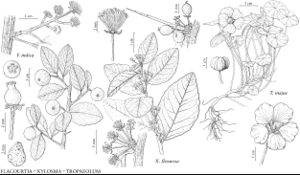Flacourtia
Stirp. Nov., 59, plates 30, 30 bis. 1786.
| Taxon | Illustrator ⠉ | |
|---|---|---|
 | Flacourtia indica Xylosma flexuosa Tropaeolum majus | John Myers John Myers Barbara Alongi |
Trees or shrubs, usually not heterophyllous, not clonal; branching sympodial. Stems usually spinose, sometimes unarmed, spines simple and/or compound. Leaves usually persistent, sometimes deciduous; stipules minute; petiole not glandular. Inflorescences axillary or terminal (on lateral twigs), few-flowered, racemelike-cymes [2-flowered fascicles], pistillate flowers sometimes solitary. Pedicels articulate near base. Flowers (unisexual and/or bisexual, fragrant [not]); sepals 4–7; disc lobed; stamens ca. 15–30; filaments distinct; ovary [2–] 5–7 [–10] -carpellate (and locular, placentation axile, placentae intruded and fused); styles (persistent) connate basally [entirely and columnar]; stigma notched-capitate or truncate. Fruits drupaceous. Seeds: aril absent. x = 11.
Distribution
Introduced; Fla., s Asia, c, s Africa, Indian Ocean islands, Pacific Islands
Discussion
Species ca. 15 (1 in the flora).
Selected References
None.